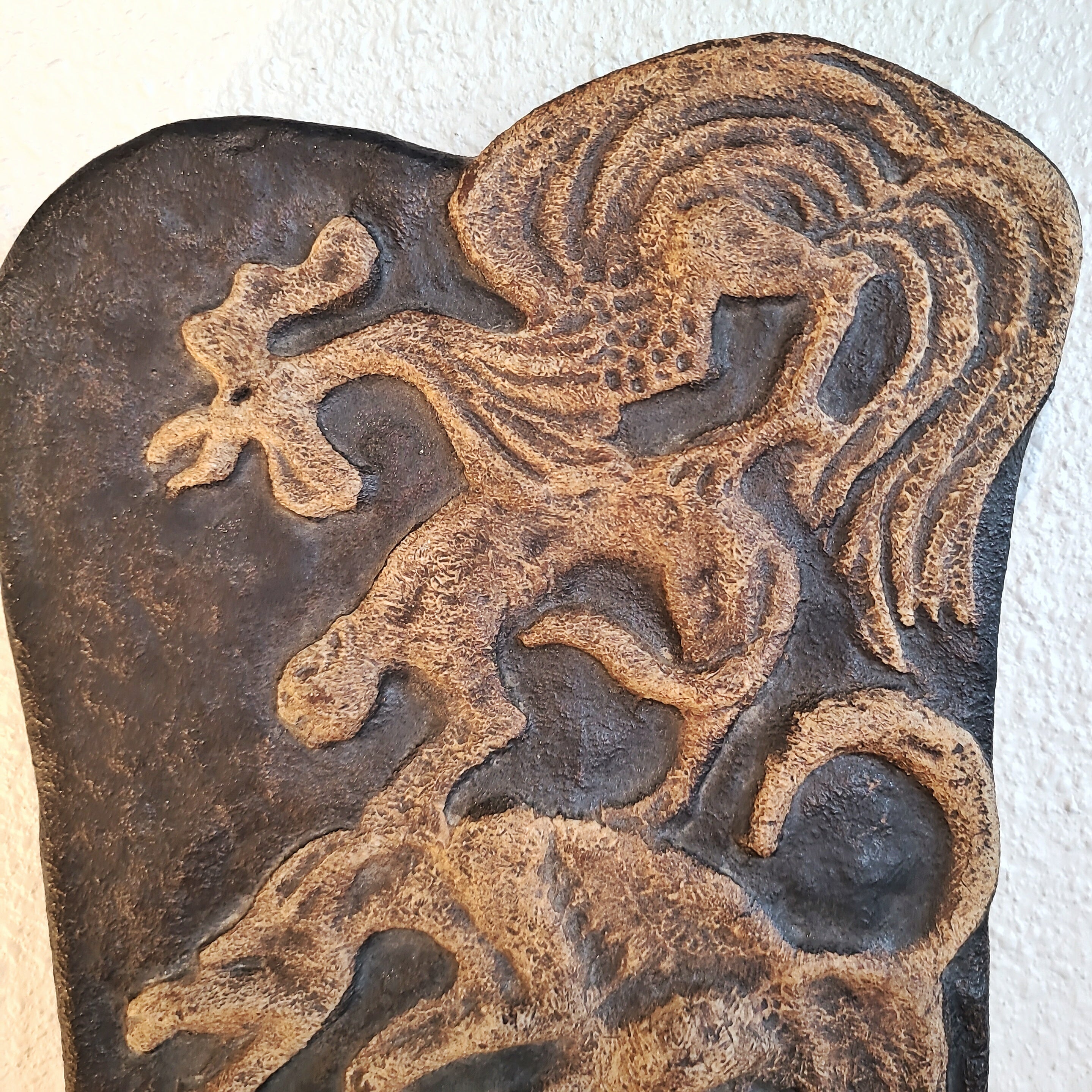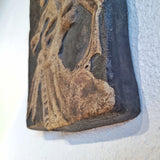






GERHARD LIEBENTHRON “BREMEN TOWN MUSICIANS” PLAQUE
CONTACT US HERE ABOUT THIS ITEM.
Some day you will be old enough to start reading fairy tales again. – C.S. LEWIS (1898–1963)
A stoneware plaque from the German master Gerhard Liebenthron depicting the pivotal nighttime climax of Die Bremer Stadtmusikanten (the Bremen Town Musicians), as recorded in the 1819 edition of Grimms’ Fairy Tales. Liebenthron portrays the cast of aging, cast-off protagonists—the ass, the dog, cat, and cock—in an eerie twilight, à l’attaque. Bremen was home to Liebenthron’s studio.
(Spoiler alert: though they never make it to the eponymous town, the musicians do manage to “live happily for the rest of their days.”) The brick red chamotte clay is characteristically incised on the reverse with Liebenthron’s initials and the production year: GL83 (1983).
GERHARD LIEBENTHRON (1925–2005) was born in the small town of Neustrelitz in northeast Germany and raised in Berlin. The zeitgeist of late interwar Germany remained a lifelong creative inspiration for him. Post-Weimar Berlin famously epitomized the clash of ideologies: Marxist Socialism, Capitalist Democracy, and the competing Totalitarianisms of Communism and Fascism. At the same time, Surrealism was dominating Europe’s art world, and its influence was felt around the globe. Artists such as Frida Kahlo and Diego Rivera in Mexico, for example, worked to integrate the movement’s ideas into their revolutionary credos. In this climate, the young Liebenthron first sought employment as a theatrical scene painter. The 1939 outbreak of WWII, however, thwarted this impulse. Having enlisted in the Nazi Wehrmacht, Liebenthron spent much of the war’s duration as a prisoner of the Allies. Following his release in the mid-’40s, he found temporary work painting ceramic vases; this happy encounter with clay would determine his future career as an artist.
From 1945 to 1951, Liebenthron studied in Bremen at the Staatliche Kunstschule (State School of the Arts) in the pottery class of Else Krieg and Dorothee Colberg-Tjadens. During his final year, he served as a sculptor’s assistant to Prof. Ernst Goersemann. In 1952, his schooling complete, he opened a workshop on the famous Bӧttcherstraße, a historic market street in Bremen’s town center. Liebenthron’s early output consisted of arbitrarily shaped vessels and wall plates. The decoration was by turns expressive, abstracted, and figurative—or inconspicuous, ornamental, and color-intensive—evoking the work of the French artists of Vallauris (e.g., Roger Capron and Gilbert Portanier). His work was regularly presented in Die Schaulade and its successor Gestalt, important arts and crafts journals of the day, from 1954 on. As early as 1955, he was participating in national and international ceramics exhibitions.
Liebenthron switched exclusively to stoneware in the 1960s, seeking inspiration from rural German ceramics as well as various foreign traditions, especially the work of the Japanese, which was being popularized in Europe at the time. He produced a wide range of objects: from bowls, jugs, and vases on a domestic scale to larger, less functional pieces. His most monumental work seems to aspire to the status of sculpture. He was able to fuse East and West in ways that never devolved into pastiche.
In 1969, Liebenthron exchanged brightly colored glazes for thin washes of earthy pigments that suggest abstract calligraphy and drip painting. The range of forms he developed during these years demonstrates an impressive capacity to produce in the context of different styles while adhering to the rubric that won him his original notoriety: simple elegance and idiosyncratic form. Many of his pieces are highly sought after today, and his work can be found in several German museums: the Keramik Museum in Berlin, the Focke-Museum in Bremen, and the Hetjens Museum of German Ceramics in Düsseldorf. Liebenthron died in Bremen in 2005.
DETAILS
Designer – GERHARD LIEBENTHRON
Production Year – 1983
Origin – WEST GERMANY
Styles/Movements – MID-CENTURY; MODERNIST; EUROPEAN RUSTIC
Materials – STONEWARE
Colors – TAN, COFFEE
Condition – Excellent vintage condition.
Dimensions – 7 ¾ʺ W × 1 ⅛ʺ D × 12ʺ H







